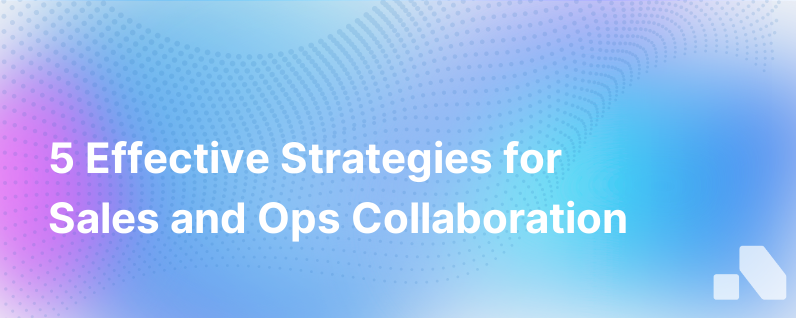5 Ways To Build A Strong Relationship Between Sales And Sales Ops
Published on July 24, 2023 by Sawyer Middeleer
In the fast-paced world of B2B sales, the symbiosis between sales and sales operations (sales ops) is essential for success. Sales reps are on the front lines, hustling to meet quotas and close deals, while sales ops work diligently backstage, ensuring the process runs smoothly and efficiently. When these two teams operate in harmony, companies see improved sales performance, higher revenue growth, and better customer experiences.
Yet in many organizations, a disconnect persists. Bridging this gap is not merely about improving communication; it's about forging a partnership where both teams feel mutually respected and invested in each other's success. With that in mind, here are five strategic ways to cultivate a robust relationship between sales and sales ops:
1. Foster Open Communication
Open and transparent communication is the foundation of any strong relationship. To break down silos between sales and sales ops:
-
Conduct regular and structured meetings: Both teams should meet consistently to discuss objectives, share feedback, and align on strategies and tactics. This could mean weekly or bi-weekly stand-ups that allow for quick syncs, as well as more extended monthly or quarterly meetings for in-depth discussions.
-
Establish clear channels of communication: Whether it's Slack, Microsoft Teams, or another platform, ensure there's an agreed-upon communication channel for day-to-day conversations, updates, and assistance requests.
-
Encourage a feedback culture: Value and act upon the insights and suggestions from each team. Sales reps can provide on-the-ground feedback on what's working and what's not, while sales ops can follow up with data and analysis to corroborate and devise solutions.
2. Align on Goals and Metrics
For sales and sales ops to be truly in sync, both teams need to be rowing toward the same destination. This alignment starts with having shared goals and performance metrics:
-
Define common objectives: Ensure both sales and sales ops are laser-focused on the same key business goals – be it revenue targets, market penetration, or customer retention rates.
-
Agree on key performance indicators (KPIs): While individual metrics may vary, agree on core KPIs that reflect the business objectives and promote a shared sense of accountability.
-
Review and adjust targets together: Goals should evolve as the business grows. Regularly review targets and the processes in place to achieve them. This collaborative review can help identify any misalignments or areas for improvement.
3. Provide Mutual Education and Insight Sharing
Mutual understanding is built through shared knowledge. Each team has unique expertise that can empower the other:
-
Educate on products and sales technique: Sales ops should be well-versed in the product suite and the sales tactics being used. Periodic training sessions can help maintain this understanding.
-
Demystify data and tool usage: Conversely, sales reps should have a basic understanding of the CRM and analytics tools sales ops utilize. Training sessions on interpreting data and leveraging sales tools can help reps understand how their actions influence broader sales strategies and outcomes.
-
Share insights and best practices: By regularly sharing insights such as industry trends, customer feedback, and success stories, both teams can learn from each other's experiences and apply that knowledge to their work.
4. Integrate Planning and Execution
Strategic planning is more effective when both sales and sales ops bring their perspectives to the table. Integration of both teams during the planning stages helps ensure buy-in and smooths execution because both sides understand and have shaped the strategy.
-
Collaborate on strategic initiatives: When rolling out new go-to-market strategies or sales campaigns, early involvement from both teams can ensure strategic alignment and operational feasibility.
-
Jointly develop sales enablement resources: Sales ops can provide valuable insights into what types of content and tools would help sales reps move deals through the funnel more effectively.
-
Create joint task forces for key projects: Temporary cross-functional teams can tackle specific challenges or opportunities, fostering collaboration and shared ownership.
5. Celebrate Successes and Learn from Failures Together
Sharing in the highs and learning from the lows can help bridge any emotional distance between sales and sales ops:
-
Recognize and celebrate wins: Whether it's closing a big deal or successfully implementing a new sales tech stack, take the time to acknowledge contributions from both teams.
-
Conduct post-mortems as a team: When things don't go as planned, come together to dissect what happened. Use a blame-free approach to understand the lessons and improve going forward.
-
Share success stories: Encourage members from each team to share stories of success, no matter how small, to boost morale and show how their collaboration directly contributes to the company's success.
Incorporating Sales Ops Platforms like Aomni
In the spirit of fostering this strong relationship, tools like Aomni offer a sophisticated AI platform designed to streamline and enhance sales operations. With features like real-time account research, competitive insights, and personalized sales content, Aomni aids in bridging the communication gap between sales and sales ops, offering tangible evidence of their collaboration and contribution to the company's success.
By integrating platforms like Aomni, sales reps have quick access to the data and materials they need to sell strategically. Meanwhile, sales ops benefit from the efficiency gains and data-driven insights that the technology provides. This mutual benefit helps reinforce the partnership and shared goals of both teams.
Conclusion
Aligning the sales and sales ops teams is crucial for sustaining growth and achieving operational excellence. By fostering open communication, aligning on goals, offering mutual education, integrating planning and execution, and celebrating shared successes, you can create a synergistic partnership that propels your company forward. And with the support of advances in technology, like those provided by Aomni, both teams can unlock new levels of strategic selling and operational efficiency.